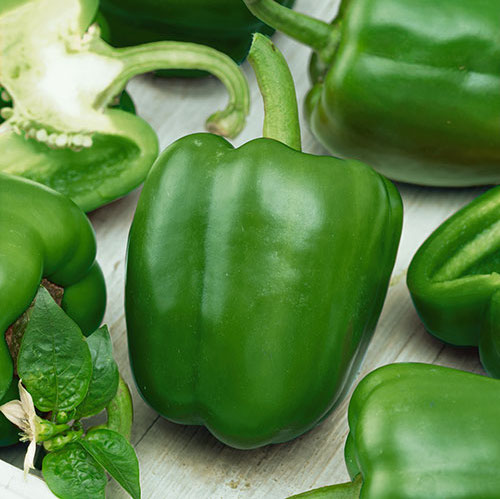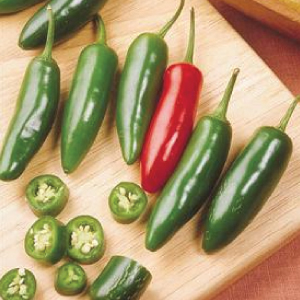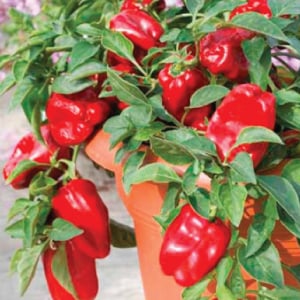
Learning Download: How to Grow Peppers
From Seed to Harvest: A guide to growing peppers.
Peppers come in all different shapes, sizes and flavors with the most common being the bell pepper. They range in flavors from sweet and mild to extra hot and can be eaten raw, stuffed or added to recipes. Although some gardeners purchase pepper plant starters instead of growing the plant from seed, gardeners who opt to grow plants from seed will have more options when it comes to the type of pepper plants they want.
To plant:
Sine peppers are warm-weather pants with a long growing season, gardeners in norther climates can begin their peppers inside. Begin peppers indoors eight weeks before the last frost date, but if you’re planting hot peppers, you can plant them up to 12 weeks indoors before the last frost date. Plant seeds 1/4 inch deep by laying the seeds on top of the soil and gently poking them below. If planting hot pepper seeds, be sure to wear gloves during the process. If planting peppers in a seedling tray indoors, add a plastic lid after planting to encourage warm and most soil, which quickens the germination process.
Pepper seeds also can be soaked in a cup of warm water with a teaspoon of hydrogen peroxide for up to eight hours prior to planting to quicken the germination process. When transplanting, peppers grow well in the garden but also are great for containers or pots.
To grow:
Transplant the pepper seedlings to the garden one week after the last frost date. When transplanting, space plants 12 to 18 inches apart. Plant in an area with full sun. Once fruits begin to appear on the pant, the plant may become weighed down and require extra support, such as a tomato cage or a stake. Although peppers need water, don’t overwater the soil to make it sodden.
To harvest:
Peppers are harvestable whenever they reach the desired size. Green peppers are just immature red, yellow, orange and purple peppers. To harvest, hold the plant and cut the pepper from the stem so it doesn’t damage the plant. Sweet varieties can be ready for harvest in as little as 60 days, whereas the hot peppers take longer to grow, such as up to 150 days. Jalapeños are ready to harvest when their color is a deep, dark green and other hot varieties typically mature fro green to their final coloring, such as yellow or red, when they are ready for harvest. For hot peppers, harvesting encourages more growth. Be sure to use gloves when harvesting hot peppers.
What peppers crave:
Once a pepper plant’s first true leaves form, it is time to fertilize. Although fish emulsion and compost can be worked into the soil prior to planting, pepper plants like to be fed throughout their growing season as well. Top dress the soil with a granular fertilizer once or twice during the growing season and a liquid fertilizer once or twice throughout the growing season. When the plants are young, don’t use the full fertilizer dosage, but increase the strength as the peppers grow.
Where to buy pepper seeds:
You can find different kinds of peppers from bell peppers ranging in colors as well as pepper mixes, like the rainbow bell pepper blend at Urban Farmer.
Learning Download: How to Grow Hot Peppers
From Seed to Harvest: A beginner’s guide to growing hot peppers
Peppers may be one of the most popular vegetables gardeners choose to grow, but there is a major different between growing conventional peppers and hot peppers. Growing hot peppers from seed allows for diversity and spice in dishes, but certain steps must be followed to ensure the best possible outcome.
To plant:
When it comes to growing hot peppers, there are certain types of hot peppers that are easier to grow than others. Typically, hot peppers require warmer soil temperatures to germinate, but certain varieties require warmer temperatures than others. For example, hot peppers like jalapeños, serrano peppers, cayenne peppers, poblano peppers, ornamental peppers and Thai peppers require cooler soil temperatures than other types of hot peppers. Jalapeños and the other peppers in that family only need soil with a temperature of 50-70 degrees to germinate. Habaneros, scotch bonnets and other hot peppers require warmer soil to germinate, such as 75-90 degrees.
Plant the seeds during the winter months, such a anytime between November and February, to give the seedlings plenty of time to grow before transplanting them outside.
Before planting, soak the seeds overnight in warm water. Soaking the seeds allows them to sprout quicker and better than when not soaking them. You can plant the seeds the morning after soaking them in warm water.
You won’t immediately plant the seeds outdoors and will instead begin them indoors. Plant the seeds in peat pellets, but follow the instructions on the pellets in order to add water and allow the peat to expand before planting the seeds. Plant three of the same hot pepper seeds in a 1/4 inch hole and loosely cover with soil. Do not pat the soil down because you want the seedlings to break through the soil’s surface easily.
Apply a soil additive such as Myco Blast immediately after the planting the seeds to enrich the soil. Water once a week until the first set of true leaves appear on the seedling.
Since hot peppers take much longer to germinate than other peppers, you can quicken the germination process by placing the peat pellets on a seedling heat mat. This warms the soil and encourages the seeds to germinate faster.
Once the seedlings sprout, remove the greenhouse dome that comes with the peat pellets and place them in a well-lit area such as a window. you can also add a grow light to create more light when the sun sets early in the winter months. Mist the seedlings with water to keep the soil moist but not wet.
Once the three seedlings in each cup reach two inches in height, remove all but the strongest seedlings.
When seeds reach this stage, you can transplant them into bigger cups.
To grow:
It is time to transplant your seedlings when the last frost has passed and nightly temperatures are above 50 degrees. Plants should be around 8 weeks old and they shouldn’t have any blooms yet. If they do have blossoms, pinch off the blossoms prior to transplanting so energy will be directed to adjusting to the transplant.
Before transplanting, harden off your plants by placing them outside in half-hour increments in an area protected from the wind. Gradually increase this time up to 8 hours a day. Hot peppers need temperatures of at least 70 to 80 degrees during the day to grow. To transplant, dig a hole slightly bigger than the size of the seedlings root ball and plant them in the ground. Be sure to space the plants several inches apart.
Keep in mind you will have to water the plants more frequently than when they grew indoors. Since peppers are heavy and their branches are brittle, stake the plants or use cages to support them.
To harvest:
Peppers are ready to harvest when they change color. For jalapeños, this means deepening to a dark green. Other hot peppers will transition form a green color to the color they are supposed to be, such as orange or yellow. To harvest, use gloves when picking and use hand pruners or scissors to snip the pepper from the plant.
What hot peppers crave:
Fertilizing begins when the seedlings are still indoors and the first true set of leaves have appeared. Use a diluted fish emulsion fertilizer. Use 1/4 of the strength suggested. When there are four sets of true leaves, fertilize the plants with magnesium sulfate, also known as Epsom salt. Mix a tablespoon of Epson salt with a gallon of water, shake and apply to the leaves and stem. Be sure the Epsom salt isn’t scented. The Epsom salts keep the foliage strong.
When transplanting, add bone-meal to the soil because pepper plants eat up lots of calcium as they grow.
Where to buy hot pepper seeds:
You can find many varietals of hot pepper seeds such as jalapeño, serrano, habanero and may more at Urban Farmer.
Learning Download: Common pests and diseases: Peppers
Common pests and diseases: Peppers
When growing vegetables, it is always exciting to care for the plant throughout its growing phase and then harvest it for delicious recipes later on, but one thing to watch out for is pests and diseases. Different plants are susceptible to different types of pests and diseases, and it is important to make yourself aware so you can keep a watchful eye and also take any preventative methods to keep your plants safe throughout their lifespan.
Peppers can fall victim to several different pests and diseases.
Pests:
Some of the common pests affecting pepper plants include aphids, the beet armyworm, the Colorado potato beetle and leafminers.
Aphids will be soft-bodied insects usually showing up on the undersides of the leaves. They will be green or yellow in color. The aphids secrete a sticky substance which can cause mold. Knock the aphids off the leaves with a jet of water. Only use insecticides if the infestation is out of control.
The beet armyworm will cause singular or multiple group holes in the foliage of the plant. Apply Bacillus thuringiensis and encourage natural enemies.
The Colorado potato beetle can cause complete defoliation if the infestation is bad enough. The adult will emerge in the spring, and they can lay eggs in up to two dozens at a time. The eggs are laid on the undersides of the leaves. Most of these beetles have insecticide resistance, but if you plant early-maturing peppers, they may escape damage. Spinosad is effective against the adult beetles.
Leafminers can create white splotches on the leaves and the leaves will fall off the plant. If the leafminers infect the plant when it is young, it can reduce the plant’s yield. Remove plant debris from the soil immediately after harvest to prevent this, and use insecticides once the damage is identified.
Diseases:
Some of the common diseases affecting pepper plants include Anthracnose and Cercospora leaf spot.
Anthracnose causes circular lesions on the fruit, and sometimes these lesions can expand to cover the entire fruit’s surface. Plant disease-free seed and treat seeds with hot water prior to planting. Practice crop rotation and make sure you plow all crop debris into the soil after harvest to help prevent inoculum in the soil. Anthracnose is found in most vegetable-growing areas and can cause large losses to crops if untreated.
Cecospora leaf spot causes small, circular and water-soaked spots on the leaves’ surface. The lesions expand and sometimes can become brittle and crack. This is mainly an issue in more tropical areas, such as Africa, Asia and the West Indies. To manage this disease in peppers, remove all crop debris after harvest, apply the appropriate fungicides and practice crop rotation.
Learning Download: Hot Pepper Comparison Chart
Hot Peppers Comparison Chart
| Heat | Variety | Days | Size | Color |
| Extremely Hot | 7 Pot Douglah | 90-110 | 2-3 inches | green to dark brown |
| Extremely Hot | Carolina Reaper | 100-125 | 3-4 inches | red |
| Extremely Hot | Chocolate Bhut Jolokia (Ghost Pepper) | 100 | 2-3 inches | brown |
| Extremely Hot | Devil’s Tongue | 100 | 3-4 inches | yellow |
| Extremely Hot | Purple Bhut Jolokia (Ghost Pepper) | 110 | 3-4 inches | purple |
| Extremely Hot | Red Bhut Jolokia (Ghost Pepper) | 100 | 3-4 inches | red |
| Extremely Hot | Trinidad Scorpion Butch T | 100 | 2-3 inches | red |
| Extremely Hot | White Bhut Jolokia (Ghost Pepper) | 100-125 | 3-4 inches | white |
| Extremely Hot | Yellow Bhut Jolokia (Ghost Pepper) | 110 | 3-4 inches | yellow |
| Extremely Hot | Yellow Scotch Bonnet | 95 | 2 inches | yellow |
| Hot | Caribbean Red Habanero | 105 | 2-3 inches | green to red |
| Hot | Chocolate Habanero | 95 | 2-3 inches | brown |
| Hot | Lemon Drop | 100 | 2-3 inches | yellow |
| Hot | Orange Habanero** | 100 | 2-3 inches | green to orange |
| Hot | Peach Habanero | 95 | 2-5 inches | peach yellow |
| Hot | Tabasco | 75 | 1-2 inches | green to red |
| Medium | Anaheim Chili** | 75-80 | 5-8 inches | green and red |
| Medium | Bolivian Rainbow | 125 | 1-2 inches | cream to purple to orange to red |
| Medium | Cayenne Long Red Slim** | 85-90 | 4-6 inches | green to red |
| Medium | Cayenne Long Red Thick | 75 | 5 inches | green to red |
| Medium | Chile de Arbol | 95 | 2-3 | red |
| Medium | Early Jalapeño** | 65 | 3-4 inches | dark green |
| Medium | Guajillo | 85 | 3-4 inches | green to orange/red |
| Medium | Holy Mole* | 85 | 6-8 inches | dark green |
| Medium | Jalapeño M** | 75 | 3-4 inches | green to red |
| Medium | Peter | 95 | 4-6 inches | red |
| Medium | Serrano | 85 | 3-6 inches | green to red |
| Medium | Super Chili* | 75 | 5-8 inches | green to red |
| Medium | Big Jim** | 70-80 | 4-6 inches | green and red |
| Medium | Count Dracula | 100 | 2 inches | black to red |
| Mild | Ancho** | 75 | 4-6 inches | green |
| Mild | Beaver Dam** | 80 | 5-8 inches | orange to red |
| Mild | Cajun Belle | 60 | 2-3 inches | green and red |
| Mild | Hungarian Hot Wax** | 65-70 | 6-8 inches | yellow to orange to red |
| Mild | Joe Parker** | 70-95 | 5-8 inches | green to red |
| Mild | Time Bomb | 65-70 | 1-2 inches | green to red |
*All American Selection Winner
**Heirloom
***AAS Winner/Heirloom



